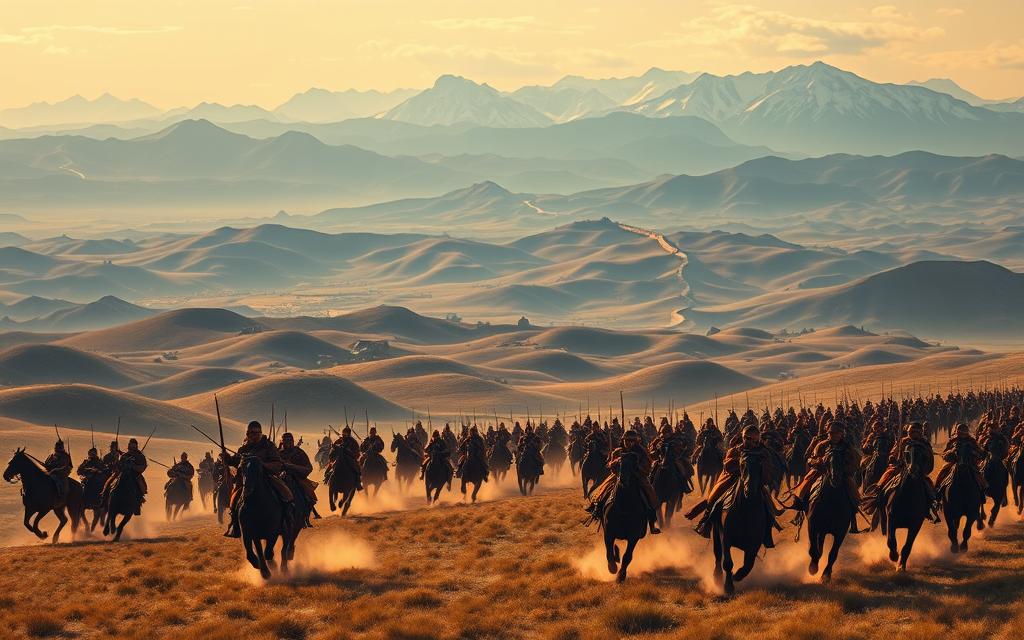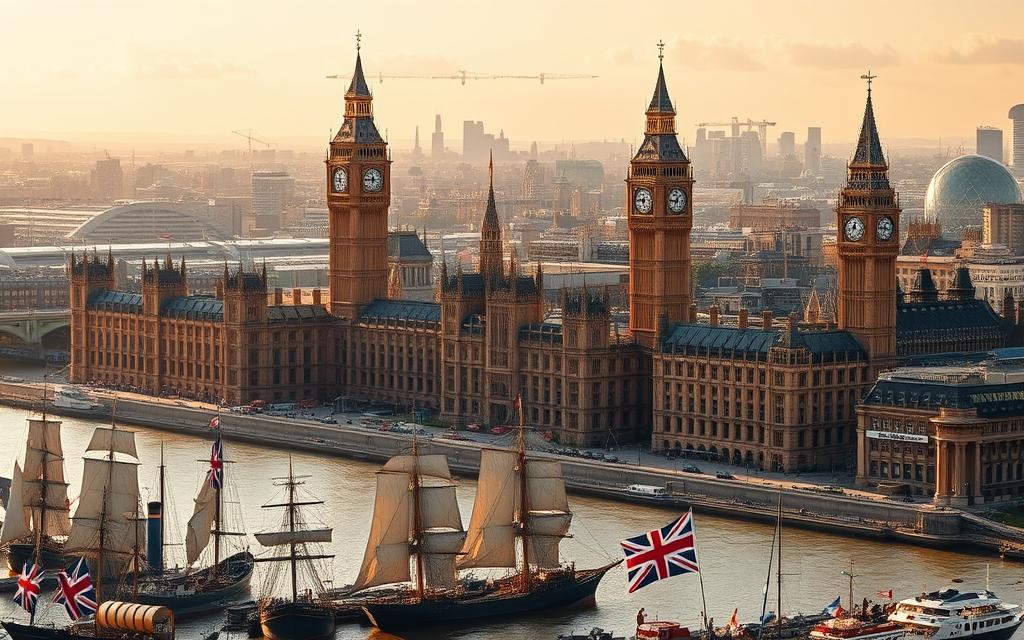Throughout history, great empires have risen and fallen, leaving behind valuable historical lessons. The stories of these empires captivate us, offering insights into the complexities of power, governance, and societal dynamics.
By examining the past, we can glean important lessons from the past that can inform our decisions about the future. Understanding the factors that contributed to the decline of great empires can help us build more resilient societies.
This article will explore the rise and fall of historical empires, extracting historical lessons that can guide us toward a more sustainable future for future empires.
The Cycle of Rise and Fall Throughout History
Throughout history, empires have risen and fallen in a cycle that continues to fascinate and educate us today. Understanding this cycle can provide valuable insights into the nature of power, governance, and societal development.
Defining What Makes an Empire “Great”
A “great” empire is typically characterized by its military prowess, economic dominance, cultural achievements, and the ability to exert significant influence over other nations or territories. The Roman Empire, for example, was renowned for its military might, administrative efficiency, and cultural legacy.
The Recurring Pattern of Imperial Lifecycles
Empires often follow a predictable lifecycle, marked by phases of expansion, peak, and decline. This pattern is evident in various historical contexts, from the ancient civilizations of Mesopotamia to the colonial empires of Europe.
| Empire | Peak Period | Factors Contributing to Decline |
|---|---|---|
| Roman Empire | 1st-2nd century AD | Internal corruption, external pressures, economic strain |
| Mongol Empire | 13th century | Fragmentation, loss of central leadership, external invasions |
| British Empire | 19th-early 20th century | Economic overextension, rise of nationalist movements, global conflicts |
The study of these historical patterns can inform our understanding of the challenges faced by modern societies and the importance of sustainable governance.
The Roman Empire: From Republic to Ruin
The Roman Empire’s trajectory from a robust republic to a state of ruin is a complex tale of power, corruption, and decline. At its zenith, Rome was a paragon of governance, engineering, and military prowess.
Pillars of Roman Dominance and Expansion
The Roman Empire’s dominance was built on several key pillars, including a strong military, efficient administrative systems, and strategic expansion through conquests. Efficient governance and military strength were crucial to its success.
| Pillar | Description | Impact |
|---|---|---|
| Military Strength | Well-organized and disciplined legions | Enabled conquests and maintained order |
| Efficient Governance | Administrative systems and laws | Facilitated expansion and stability |
| Economic Prosperity | Trade and resource management | Supported military and administrative costs |
Critical Factors in Rome’s Decline and Fall
The decline of the Roman Empire was precipitated by several critical factors, including political corruption and economic instability.
Political Corruption and Leadership Crisis
Corruption within the Roman political system eroded its foundations, leading to ineffective leadership and instability.
Economic Instability and Military Overextension
The empire’s extensive military campaigns and maintenance of a vast territory led to economic strain and military overextension.

Eastern Empires: Lessons from China and Mongolia
The rise and fall of Eastern empires, particularly in China and Mongolia, offer valuable historical insights into the dynamics of power and imperial longevity. These regions have been home to some of history’s most influential empires, with their experiences providing crucial lessons on the factors that contribute to imperial success and decline.
The Rise and Fall of Chinese Dynasties
Chinese history is marked by the cyclical rise and fall of dynasties, each leaving its mark on the country’s cultural, political, and social landscape. The Qin and Han dynasties are notable for their significant contributions to Chinese identity and governance. However, internal strife, external pressures, and economic strain often precipitated their downfall.
The Mongol Empire’s Rapid Expansion and Fragmentation
The Mongol Empire, under the leadership of Genghis Khan, expanded rapidly across vast territories, creating the largest contiguous empire in history. 
Genghis Khan’s Unification Strategy
Genghis Khan’s success was largely due to his innovative military tactics and a unifying strategy that integrated diverse tribes and peoples into the Mongol Empire, fostering a sense of unity and shared purpose.
Succession Problems and Cultural Assimilation
However, the Mongol Empire faced significant challenges following Genghis Khan’s death, including succession problems and cultural assimilation, which led to its fragmentation into smaller khanates. These issues highlight the difficulties of maintaining a vast empire over time.
Colonial Powers: The Spanish and British Empires
The rise and fall of colonial empires, such as those of Spain and Britain, offer valuable insights into the dynamics of power and the consequences of imperial overreach. These empires, once at the zenith of global influence, experienced gradual declines that were influenced by a variety of factors.
Spain’s Golden Age and Gradual Decline
Spain’s colonial expansion in the Americas during the 16th century marked the beginning of its golden age, characterized by vast riches and extensive territorial control. However, the exploitation of resources and the native populations led to significant social and economic strain. Economic exploitation and poor resource management were critical factors in Spain’s gradual decline.
The British Empire’s Global Reach and Dissolution
The British Empire, at its peak, was the largest empire in history, covering a quarter of the world’s land area and encompassing a fifth of the global population. Its global reach was accompanied by significant economic and military power. However, the costs of maintaining such vast territories, coupled with the rise of nationalism in colonized countries, contributed to its dissolution.
Economic Exploitation and Resource Management
Both the Spanish and British Empires were characterized by economic exploitation of their colonies. The extraction of natural resources without adequate investment in local infrastructure or consideration for sustainability led to long-term negative consequences for the colonized regions.
Nationalism and the Decolonization Movement
The rise of nationalism in colonized countries played a crucial role in the decolonization movement. As local populations became increasingly aware of their rights and sought independence, the legitimacy of colonial rule was challenged, leading to the eventual dissolution of these empires.

The Ottoman Empire: Between East and West
Spanning over 600 years, the Ottoman Empire’s history is a complex narrative of expansion, modernization, and eventual collapse. At its zenith, it was a dominant force, bridging East and West.
Factors Behind Ottoman Longevity
The Ottoman Empire’s longevity can be attributed to its strategic location, effective administrative systems, and military prowess. Its ability to adapt and incorporate various cultures contributed to its stability.
Modernization Failures and Imperial Collapse
Despite its strengths, the Ottoman Empire faced significant challenges in the modern era, including failed modernization attempts and internal strife. These factors weakened the empire, making it vulnerable to external pressures.
The Sick Man of Europe: Reform Attempts
The Ottoman Empire was often referred to as the “Sick Man of Europe” due to its declining power. Various reform attempts were made to revitalize the empire, but they were largely unsuccessful.
World War I and the Final Dissolution
The Ottoman Empire’s participation in World War I marked the final blow to its already fragile state. The subsequent partitioning of its territories led to the empire’s dissolution.
| Factor | Impact on Ottoman Empire | Outcome |
|---|---|---|
| Strategic Location | Facilitated trade and cultural exchange | Contributed to longevity |
| Modernization Failures | Weakened the empire internally | Contributed to collapse |
| World War I | Drained resources and led to partitioning | Final dissolution |
Common Threads in Imperial Collapse
A closer look at the history of empires reveals recurring patterns in their downfall. Despite their differences, the collapse of great empires often shares common underlying factors that can be identified and analyzed.
Economic Overextension and Resource Depletion
One of the primary factors in the decline of empires is economic overextension. When empires expand too rapidly, they often overextend their resources, leading to financial strain. The Roman Empire, for example, faced significant economic burdens due to its extensive military campaigns and territorial expansions.
Social Inequality and Internal Conflict
Social inequality is another critical factor that contributes to the downfall of empires. As disparities in wealth and power grow, social unrest and internal conflicts become more prevalent. The French Revolution is a classic example of how social inequality can lead to the collapse of a regime.
Leadership Failures and Institutional Corruption
Effective leadership is crucial for the longevity of any empire. However, leadership failures and institutional corruption can significantly weaken an empire’s foundations. The Byzantine Empire’s decline was partly due to internal power struggles and corruption.
Environmental Challenges and Natural Disasters
Lastly, environmental challenges and natural disasters have played a significant role in the collapse of various empires. The Mayan civilization, for instance, faced environmental degradation and droughts that contributed to their decline.
In conclusion, the fall of great empires is often the result of a combination of these factors. Understanding these common threads can provide valuable insights into the sustainability of modern societies.
The Fall of Great Empires: Lessons from the Past for Our Future
As we reflect on the rise and fall of great empires throughout history, we can distill valuable lessons for our future. The stories of these empires offer insights into the factors that contribute to their success and downfall.
Sustainable Growth vs. Unchecked Expansion
One key lesson is the importance of sustainable growth versus unchecked expansion. Empires that expanded too rapidly often struggled to maintain control and stability, ultimately leading to their decline.
Social Cohesion and Addressing Inequality
Fostering social cohesion is another critical factor. Empires that failed to address internal inequalities and social unrest often faced significant challenges to their longevity.
Institutional Resilience and Leadership Succession
Institutional resilience and effective leadership succession are also vital. Empires with robust institutions and clear succession plans were better equipped to weather challenges and maintain stability.
Environmental Stewardship and Resource Management
Finally, the importance of environmental stewardship and prudent resource management cannot be overstated. Empires that overexploited their resources or neglected environmental concerns often suffered long-term consequences.
By learning from these historical lessons, we can work towards a more sustainable and resilient future, avoiding the pitfalls that led to the downfall of great empires in the past.
Conclusion: Charting a Wiser Course Forward
The rise and fall of great empires throughout history offer valuable lessons for our future. By examining the cycles of imperial lifecycles, we can identify patterns that have contributed to their decline. The Roman Empire’s economic strain, China’s dynastic cycles, and the Mongol Empire’s fragmentation all share common threads.
Understanding these historical lessons is crucial for charting a wiser course forward. As we face our own global challenges, we can draw on the experiences of past empires to inform our decisions. By prioritizing sustainable growth, social cohesion, and environmental stewardship, we can mitigate the risks of imperial collapse.
The future implications of these lessons are clear: by learning from the past, we can build a more resilient future. By applying these insights, we can create a world that is better equipped to navigate the complexities of an ever-changing global landscape.







